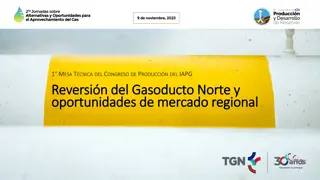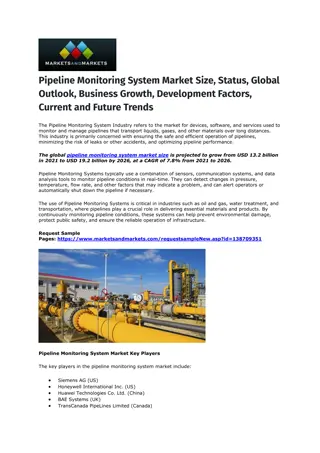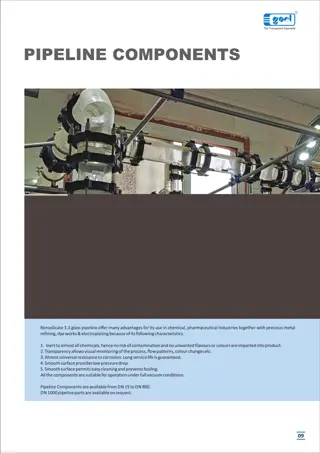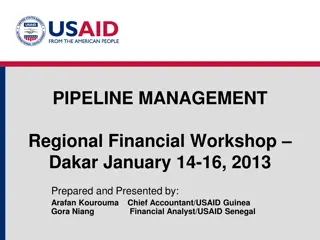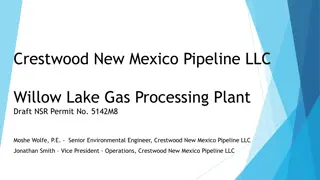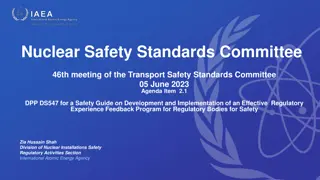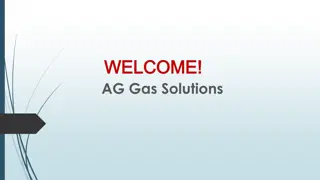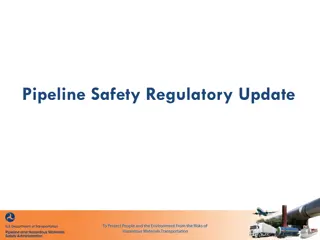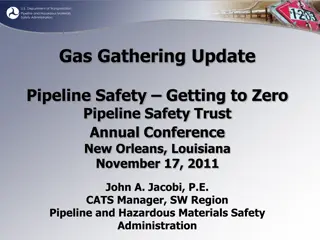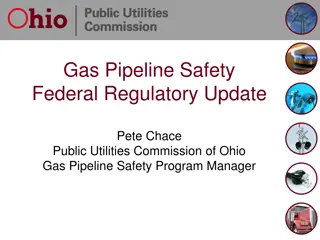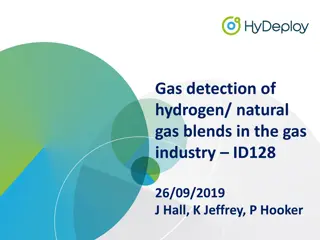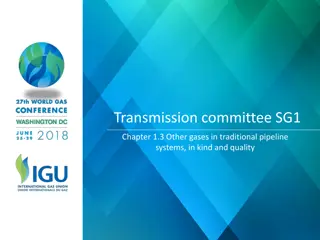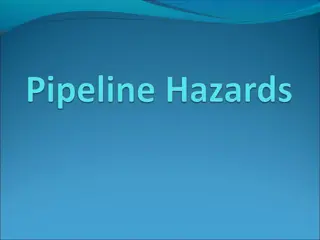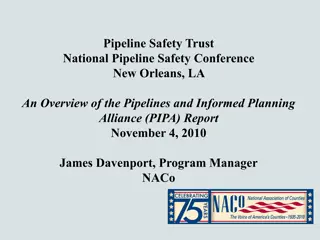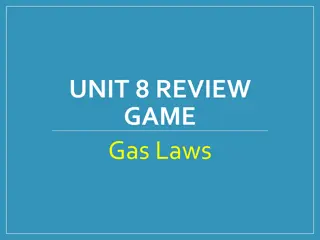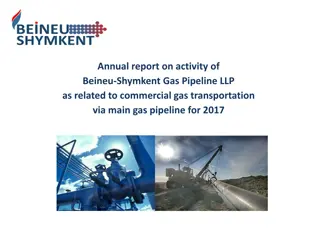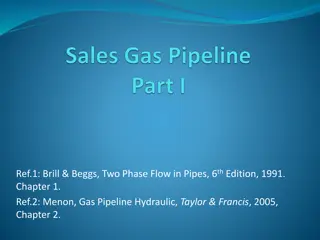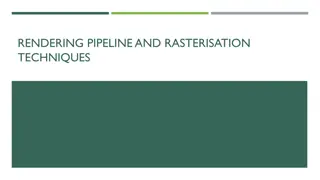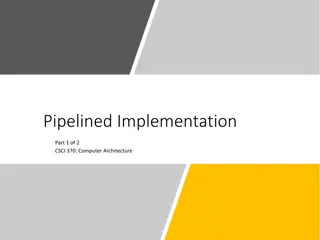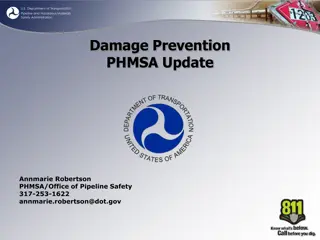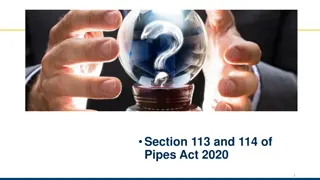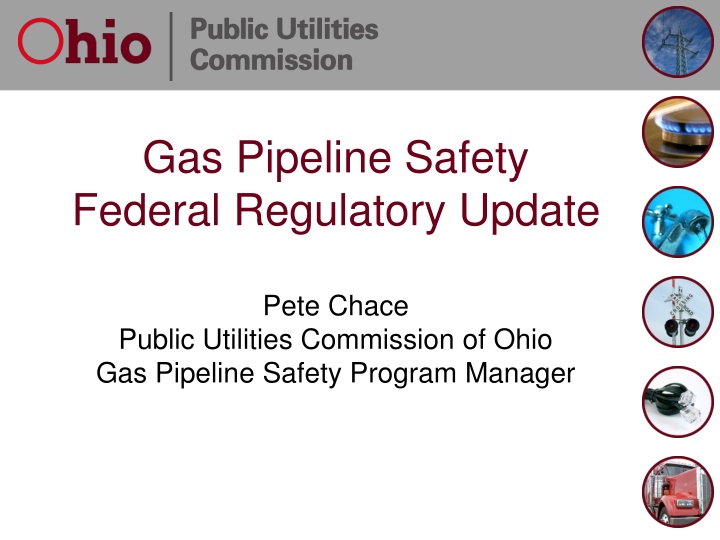
Gas Pipeline Safety & Federal Regulatory Update
This update covers recent amendments, the federal rulemaking process, operator qualification, incident notification, cost recovery, and more in the gas pipeline safety sector. Stay informed on legislative changes and regulatory requirements for ensuring the safety and integrity of gas pipelines.
Download Presentation

Please find below an Image/Link to download the presentation.
The content on the website is provided AS IS for your information and personal use only. It may not be sold, licensed, or shared on other websites without obtaining consent from the author. If you encounter any issues during the download, it is possible that the publisher has removed the file from their server.
You are allowed to download the files provided on this website for personal or commercial use, subject to the condition that they are used lawfully. All files are the property of their respective owners.
The content on the website is provided AS IS for your information and personal use only. It may not be sold, licensed, or shared on other websites without obtaining consent from the author.
E N D
Presentation Transcript
Gas Pipeline Safety Federal Regulatory Update Pete Chace Public Utilities Commission of Ohio Gas Pipeline Safety Program Manager
Federal Rulemaking Process Legislation Congress passes a law that prescribes general goals for the agency. Advance Notice of Proposed Rulemaking (ANPR) agency publishes initial analysis of legislative intent and asks for public comment (optional). Notice of Proposed Rulemaking (NPRM) agency publishes proposed rule language after review by Federal Office of Management & Budget (OMB), with a public comment period. Final Rule published with response to issues raised by public comment, subject to judicial review
Federal Rulemaking Process 2017 executive order stating that for every new regulation created, two have to be withdrawn. Total incremental cost of all new regulations, including repealed regulations, to be finalized this year shall be no greater than zero . This restriction applies across the entire DOT, cuts could be made to PHMSA regulations to justify new regulation elsewhere or vice versa.
Recent Rule Amendments 1/1/2016 Excavation Damage Prevention (created 49 CFR 196 Federal enforcement) 1/18/17 Underground Natural Gas Storage (interim final rule current stay of enforcement) 3/24/17 Operator Qualification, Cost Recovery, Accident and Incident Notification, Misc. 4/14/17 Excess Flow Valves for Multi-person Dwellings (EFV s for multi-person dwellings, curb valves or EFV s for services over 1,000 SCFH, customer notification)
Operator Qualification, Cost Recovery, Incident Notification Portion of the rule covering OQ was removed for a future rulemaking (the proposed two part test ) Incident reporting time of 1 hour after confirmed discovery . Within 48 hours of confirmed discovery, revise or confirm the initial telephonic notice. Telephonic notices do not need to be retracted. Only 30 day reports do. 1-844-OHCALL1 (1-844-642-2551)
OQ, Cost Recovery, Incident Notification Farm Taps Farm Tap = a service line supplied from a Transmission, Gathering, or Production line Rule excludes farm taps from DIMP while requiring regulator inspection and testing at least once every 3 years under 192.740. First inspection and testing cycle 3/23/20. New 192.740 requirements very similar to 192.739 requirements for district regulators. PHMSA developing FAQ s, stay of enforcement?
Notes on OQ How are your contractors qualified? Do you have confidence in how they are evaluated? Span of control non OQ workers can perform a covered task if directed and observed by an individual who is qualified . How many workers are being observed at once? Management of change significant changes communicated to individuals and to the state agency [192.805(f), (i)]. For GPS you can inform us during inspection
What changes to OQ need to be communicated? Changes to procedures Use of new equipment Changes to Regulations (federal or state) Changes to Standards incorporated by reference New information from equipment or product manufacturers Newly identified tasks Findings from incident investigations
Gas Transmission / Gathering In Development NPRM released 3/15/2016 PHMSA received over 400 comments Rule is under review and may be heavily modified Will likely focus strictly on the congressional mandates in the 2006 PIPES act (evaluation of whether IM requirements should extend beyond HCA s, potential MAOP validation, automatic shutoff valve requirements).
Gas Transmission / Gathering High Level Summary Require IM assessments for non-HCA s (new 192.710 defining Moderate Consequence Area, 14/10 year initial/upkeep surveys) Strengthen Transmission repair criteria (711, 713 moving the immediate and scheduled repair concept to non-IM covered segments) Strengthen requirements for assessment methods (ICDA, SCCDA, Guided Wave, ILI) Clarify requirements for validating and integrating pipeline data (establish minimum attributes)
Gas Transmission / Gathering High Level Summary Clarify functional requirements for risk assessments (codifies some of B31.8S) Clarify requirement to apply knowledge gained through IM Strengthen corrosion control requirements (DCVG/ACVG gradient survey for new construction, CIS for low reads, interference surveys around HVAC power lines, internal corrosion monitoring) Add requirements for selected preventative and mitigative measures in HCA s to address internal
Gas Transmission / Gathering High Level Summary Add requirements for selected preventative and mitigative measures in HCA s to address internal and external corrosion Add management of change for IM Require pipeline inspection following extreme external events Include 6 month grace period to 7 year reassessment interval
Gas Transmission / Gathering High Level Summary Require reporting of MAOP exceedance Incorporate provisions to address seismicity Add requirements for safety features on pig launchers and receivers Gathering lines require reporting for all types, and some regulatory requirements Grandfather clause / inadequate records Integrity Verification Process
Incident Trends What do incident trends tell us about pipeline safety threats? Excavation Damage is the top threat for Distribution piping Time dependent threats (Material, weld or joint failure, corrosion) are the top threats for Transmission lines Damage Prevention programs appear to have some effect reducing damages
Annual Report Excavation Damages
Mechanical Coupling Failure Reports Leading leak cause is Equipment Failure (more than all others combined) Service-to-service the most common leak location Numbers of 7100 reports can vary wildly from operator to operator
Mechanical Coupling Failure Reports Operators must report failures which result in a hazardous leak during the calendar year that are associated with mechanical fittings. The reporting requirements apply to failures in the bodies of mechanical fittings, failures in the joints between the fitting and the pipe, indications of leakage from the seals associated with the fitting, and partial or complete separation of the pipe away from the fitting.
Mechanical Fitting Data leak location
Mechanical Fitting Data fitting material
Mechanical Fitting Data type of fitting
Mechanical Fitting Data fitting construction
DIMP Leak Management Leaks - 2015 Leaks - 2017 System leaks: 105 System leaks: 90 Are trends in this system going in the right direction? https://www.youtube.com/ watch?v=VRrMu7B1L2I
DIMP Leak Management Leaks - 2015 Leaks - 2017 Area 1 Area 2 Area 1 Area 2 25 25 25 15 Area 3 Area 51 Area 3 Area 51 35 20 10 40
Safety Management Systems (API RP 1173) Based on approaches from other high hazard industries - nuclear, airline, etc. Plan-Do-Check-Act: continuous improvement model Promotes a Safety Oriented Culture where communication, risk reduction and continuous improvement is part of day to day activities
Example An operator has experienced a number of excavation damages (dig-ins) in the recent past, including one resulting in an Incident. Checking the data on their PHMSA 7100 report shows a damage per thousand locate ticket rate almost twice the state average. Need a plan to reduce excavation damage.
PLAN Risk Management What is the leading cause of dig-ins? Review and update locate request procedures Establish damage investigation procedures Classify damages so the results can tell you something. Example: Locating Practices not sufficient. Sub-cause? o Incorrect facility records / maps o Facility marking or location not sufficient o Facility was not located or marked o Facility could not be found or located
DO Put the plan into action Train people on your procedures Operational Controls check to make sure the procedures are being followed Investigate failures (damages) for lessons learned Keep good records so somebody reviewing the records later can understand what happened. Have a quality control process. Stakeholder engagement Keep everyone (employees, contractors, excavators) involved. Public awareness.
CHECK Can we use what we learned to get better? Check to see if your plan is effective (damages per thousand locates) Review incident investigations and lessons learned. Any patterns? Ex: for this operator, the most common cause of a dig-in is: Locating practices not sufficient -> Facility marking or location not sufficient Further investigation shows the leading cause is that when a locate is done by contractors, no one is informing the excavator when a locate is un- toneable.
ACT Determine how your plan can be improved, and fix it Revise your procedures, contracts with third parties, evaluation and oversight, etc. to address the shortcomings identified in the Check phase. For the example: changes to contractor training program, revised contract language, periodic QC inspections of line locate jobs.
What is a Safety Oriented Culture ? https://www.youtube.com/watch? v=s0RrhkMk2zY
Questions? Pete Chace (614) 644-8983 Peter.chace@puc.state.oh.us

